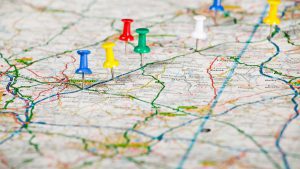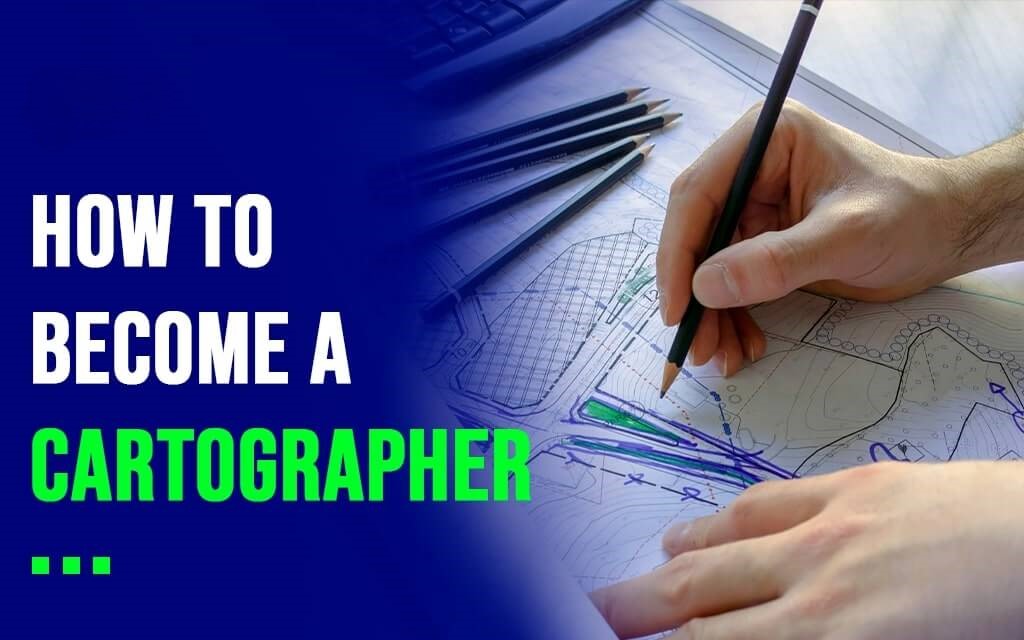Become a cartographer, a professional responsible for studying and creating maps. Cartographers support various industries and professions, including urbanisation, environmental sciences, and navigational systems, by using maps to offer an overview and pinpoint locations of features such as roads, buildings, rivers, and more. This information aids in better planning and analysis.

What are the Main Types of Cartographers?
Cartographers create maps that meet specific needs as topographic cartographers map physical features for planning and environmental studies, thematic cartographers map demographic or land use themes, GIS cartographers analyse spatial data for disaster management and resource exploration, and hydrographic cartographers chart water bodies for navigation and marine management. Their maps support various industries and disciplines by providing accurate spatial information essential for planning and decision-making.
Topographic Cartographers
Topographic cartographers are professionals who specialise in creating maps that accurately depict the physical features and terrain of the Earth’s surface. They meticulously capture details such as elevation, contours, mountains, valleys, and other natural landscapes, providing essential geographical information for various purposes including urban planning, environmental studies, and navigation.
Role and Key Responsibilities:
Topographic cartographers create maps that depict the physical features of the Earth’s surface, such as mountains and valleys. They focus on constructing topographic maps that accurately show the contours and elevations of the mapped areas.
Thematic Cartographers
Thematic cartographers are professionals who specialize in creating maps that focus on specific themes or topics, such as population distribution, climate patterns, economic activities, or other spatially relevant phenomena. These maps visually represent data to illustrate patterns and relationships within geographic areas, helping to analyse and interpret various aspects of human and natural environments.
Role and Key Responsibilities:
Thematic cartographers create maps focusing on specific themes or topics such as population density, climate patterns, economic activity, or any phenomena that can be visualised through data and represented in spatial patterns. Their maps provide insights into how these themes are distributed across geographical areas, helping to analyse and understand various socio-economic and environmental aspects.
Geographic Information Systems Cartographers (GIS)
Geographic Information Systems (GIS) Cartographers are professionals who specialise in using GIS technology to collect, analyse, and visualise spatial data. They create digital maps and databases that support various applications such as urban planning, environmental monitoring, and geographic analysis.
Role and Key Responsibilities:
GIS cartographers utilise Geographic Information Systems (GIS) technology to gather, analyse, and visualise spatial data, creating precise digital maps and databases. These resources are integral to developing sophisticated applications ranging from urban planning to environmental monitoring.
Hydrographic Cartographers
Hydrographic cartographers are professionals who specialise in studying and mapping the seabeds, coastlines, and waters of oceans, seas, and lakes. They conduct surveys to measure water depths, currents, and identify underwater features. Using this data, they create accurate nautical charts and maps crucial for safe navigation and marine exploration.
Role and Key Responsibilities:
Hydrographic cartographers specialise in studying seabeds, coastlines, and waters of oceans, seas, and lakes. They conduct surveys to measure water depths, currents, and identify marine features. Using this data, they create nautical charts and maps essential for navigation and marine exploration.
What does a Cartographer do?

A cartographer’s role involves collecting and analysing geographical data to create accurate maps and charts using GIS technology. They collaborate with other professionals, conduct field surveys for precise measurements, and ensure maps are regularly updated with new information. Cartographers play a crucial role in visualising spatial data for a variety of applications.
Collecting and Analysing Geographical Data
Cartographers are essential professionals who gather geographical data using satellites, aerial photographs, and field surveys. They analyse this information meticulously to create accurate and detailed maps that depict landscapes, terrains, and various features such as roads and rivers. Their work supports decision-making in planning, environmental management, navigation, and disaster response. Cartographers blend technical expertise with creativity to produce maps that are reliable, informative, and visually appealing, helping to advance research, exploration, and resource management.
Creating Maps and Charts
Cartographers create maps and charts that visually represent geographic information. They design map layouts, select symbols, and verify data accuracy using sources like satellites and field surveys. Their work is essential for urban planning, environmental monitoring, and navigation systems.
Using GIS Technology
Cartographers utilise GIS technology to analyse spatial data, enabling the creation of digital maps that illustrate complex issues and specific locations. GIS is integral to geography fieldwork, facilitating data analysis and report writing by managing and visualising spatial information. While GIS and maps serve various purposes, they are closely intertwined because GIS focuses on spatial management and visualisation. It integrates data from diverse sources to address spatial queries, overlaying information to enhance accuracy and uncover concealed patterns within real-world locations.
Collaborating with Other Professionals
Cartographers collaborate closely with geographers, urban planners, and environmental scientists to analyse spatial data and create accurate maps. This teamwork ensures comprehensive solutions for mapping geographic information and planning urban developments. By integrating expertise from various fields, they contribute to effective spatial analysis and sustainable resource management.
Ensuring Accuracy and Updating Maps
Cartographers maintain the accuracy of their maps through continuous verification and updates of information. This involves reviewing existing data for any discrepancies or outdated details, and making necessary adjustments to ensure the maps reflect the most current geographic information available. Regular submissions of new data and corrections contribute to the ongoing accuracy and reliability of their cartographic work.
Conducting Field Surveys
Certain cartographers, particularly those engaged in producing detailed maps such as county surveys, undertake field surveys. These surveys involve visiting specific locations to directly measure and record geographical features like distances and elevations. This practical approach ensures the accuracy and reliability of the information used to create comprehensive and precise maps.
Average Salary Range of a Cartographer
Average Salary Range of a Cartographer encompasses the typical earnings influenced by experience, geographic location, and industry specialization. Salaries vary from entry-level positions to mid-level and senior roles, with urban areas and certain industries offering higher pay due to increased demand and specific expertise requirements.
Salary Ranges Based on Experience and Location
Taking into account experience, location, and industry, salaried cartographers in the UK typically earn between £20,000 and £30,000 per year starting, and between £30,000 and £45,000 annually at mid-level. Senior or specialised cartographers can earn between £45,000 and £60,000 or more annually. In the US, these salaries range from approximately $40,000 to $60,000 for entry-level positions, $60,000 to $80,000 for mid-level roles, and $80,000 to $100,000 or higher for senior or specialised positions in related fields.
Comparison of Salaries in Different Regions and Industries
Salaries vary significantly across different regions, with urban areas and high-demand regions for mapping professionals typically offering higher pay. Cartographers employed in industry sectors such as oil and gas, environmental consulting, or other specialised fields may earn more compared to those in general mapping roles.
Factors Influencing Cartographer Salaries
Several factors can influence cartographer salaries such as,
- Experience: Greater experience typically commands higher pay as individuals become more skilled and take on greater responsibilities.
- Education and Certifications: Higher levels of education and certifications in cartography or GIS (Geographical Information Systems) can lead to increased earning potential.
- Specialisation: Specialising in specific areas of cartography, such as GIS or hydrography, can significantly impact earning potential and career advancement.
Essential Skills of a Cartographer
To become a successful Cartographer, you need to bring together technical and soft skills.
Technical Skills
- Proficiency in GIS and Cartography Software: Cartographers must adeptly utilise GIS and cartography software tools for map development and analysis.
- Understanding of Geospatial Data and Mapping Techniques: Familiarity with geospatial data and mapping techniques is essential for creating detailed and precise maps.
Soft Skills
- Attention to Detail: Geographers need to be meticulous and precise, as minor errors in maps or data organisation can result in inaccurate conclusions.
- Analytical Thinking: Cartographers rely on analytical thinking to interpret and analyse intricate spatial data effectively.
- Communication: Strong spoken and written English skills are essential for interacting with colleagues across all levels and explaining map data to visitors.
- Problem-Solving: Effective problem-solving abilities help cartographers tackle challenges and find solutions during mapping projects.
Career Development Tips for Cartographers
Continuous learning and networking through professional organisations and conferences are essential for staying updated in cartography and GIS technology. Gaining practical experience through internships and entry-level positions builds a strong foundation, while ongoing improvement of technical and analytical skills is crucial for career advancement in this field.
- Staying Updated with Technological Advancements and Mapping Techniques: Continuous learning is essential for staying current with the latest advancements in cartography and GIS technology.
- Networking Through Professional Organizations and Conferences: Joining professional organisations and attending industry conferences allows you to network with peers and access valuable resources.
- Gaining Experience Through Internships and Entry-Level Positions: Gaining practical experience through internships and entry-level positions is essential for building your career in cartography.
- Continuously Improving Technical and Analytical Skills: Continuously improving your technical and analytical skills is paramount for achieving career goals in this field.
Qualifications and Requirements for Cartographer
To become a Cartographer, specific educational and professional requirements must be met.
Educational Requirements
- Bachelor’s degree in cartography, geography, or a related field: Earn a bachelor’s degree in cartography, geography, or a related field as formal education is typically required. Most positions mandate at least a bachelor’s degree in cartography, geography, or a related discipline.
- Relevant Coursework in GIS and Remote Sensing: Completion of relevant coursework in GIS, remote sensing, and spatial analysis enhances your technical proficiency and competence in the field.
Certification Requirements (If Applicable)
- Professional Organisation Certification: Obtaining certifications, such as the GIS Professional (GISP) certification, demonstrates competency and commitment to professional standards.
- Further Education and Specialised Training: Pursuing advanced courses or specialised training in specific areas of cartography or GIS can enhance career prospects and skillsets.
Experience Requirements
- Internships and Entry-Level Positions: Gaining experience through internships with map-making or cartography firms, and entry-level roles involving Geographic Information Systems (GIS), provides valuable practical knowledge and helps establish a professional reputation.
- Practical Field Experience: Conducting field surveys and data collection exercises in geographical settings adds hands-on experience crucial for understanding real-world applications of cartographic principles.
How to Become a Cartographer?
To become a cartographer, earn a degree in cartography or geography with GIS training, gain experience through internships or entry-level GIS positions, consider GISP certification, and stay updated with industry advancements.
Completing Relevant Education
- Obtain a Bachelor’s Degree in Cartography, Geography, or a Related Field: Obtain a bachelor’s degree in cartography, geography, or a related field.
- Seek Feedback on GIS Course Assignments: Request feedback on assignments in GIS courses to improve your skills.
- Enrol in Cartography Courses with Field Trips: Choose cartography courses that include field trips for hands-on training.
- Pay Training and Course Fees in Cartography: Fulfil required fees for cartography training and courses.
- Attend Specialised GIS and Cartography Training: Participate in specialised GIS and cartography training for practical skills development.
Gaining Practical Experience
- Internships and Entry-Level Positions: Acquire practical experience through internships or entry-level positions to build skills and develop a portfolio.
- Participate in Field Surveys and Projects: Engage in field surveys and projects to gain hands-on experience and expand your practical knowledge in cartography.
Obtaining Certification (If Applicable)
- Certifications from Professional Organisations: Obtain certifications to showcase your adherence to industry standards and commitment to professional development.
- Advanced Training and Specialisations: Pursue advanced training and specialisations to deepen your expertise in specific areas of cartography or GIS, enhancing your professional credentials.
Continuing Professional Development
- Workshops, Seminars, Webinars: Participate in ongoing professional development through workshops, seminars, and webinars.
- Advanced Training and Specialisations: Further your expertise by pursuing advanced training and specialisations in specific areas of cartography or GIS.
Networking
- Professional Associations: Become a member of organisations like the American Society for Photogrammetry and Remote Sensing (ASPRS) to network and stay informed about industry trends.
- Networking at Industry Events and Conferences: Attend industry events and conferences to connect with professionals and gain insights firsthand.
Get Qualified as a Cartographer (CTA)
Engineering Management Concepts, Diploma in Civil Engineering
Top 8 Frequently Asked Questions (FAQ)

- Why Choose a Career in Cartography?
Cartography offers an exciting career path immersed in technology, where creating detailed maps contributes significantly to fields like urban planning and environmental conservation. Benefits include:
- Making a tangible impact on society.
- Continuous demand for your expertise.
- Membership in a respected professional institute.
- Satisfaction from aiding decision-making through your maps.
- Is Cartography a Suitable Career Choice?
Cartography is ideal if you have a passion for maps, enjoy working with technology, and excel in detailed data analysis. It suits those who are creative, technically skilled, and adept at presenting complex information clearly. Whether you prefer fieldwork or desk-based analysis, cartography promises a rewarding career.
- How much does a Cartographer Earn?
Salaries for cartographers vary based on experience, location, and industry. In the UK, starting salaries range from £20,000 to £30,000 annually, while mid-level positions earn £30,000 to £45,000 per year. Senior cartographers or specialists can earn £45,000 to £60,000 annually or more.
- Qualifications for a Career in Cartography
A bachelor’s degree in cartography, geography, or a related field is essential. Additional training courses provide crucial skills, and certification, such as from the GIS Certification Institute, demonstrates professional competence. Internships and entry-level positions offer practical experience.
- Is any Experience Required to start a career as a cartographer?
No prior experience is required to start in cartography. Begin with a bachelor’s degree, internships, and a passion for geography and mapping. Enthusiasm and a willingness to learn are key starting points.
- Career Outlook for Cartographers
The outlook for a career in cartography is promising: it remains in demand across multiple industries, providing longevity as a career path. It offers robust job security, middle-class salaries, and ample opportunities for advancement into specialised roles or management positions.
- Progression in the Cartographer Role
Typically, cartographers begin their careers as GIS technicians or junior cartographers. With accumulated work experience and advanced training, individuals progress to mid-level roles such as senior cartographer, GIS analyst, lead cartographer, or GIS manager. Further career advancement is achievable through additional training and certification in geospatial sciences, leading to roles as geospatial project manager or chief data scientist.
- Cartographer Exit Options and Opportunities
Beyond the traditional roles in cartography, the skills acquired are highly transferable, opening doors to diverse career paths. A robust background in internships and professional experience serves as a solid foundation for roles such as geospatial analyst, urban planner, environmental consultant, or remote-sensing analyst. Experienced cartographers can seamlessly transition to positions like GIS consultant, geospatial data scientist, or project manager. Many also pursue advanced degrees to enter academia as educators or researchers in cartography and related fields.


